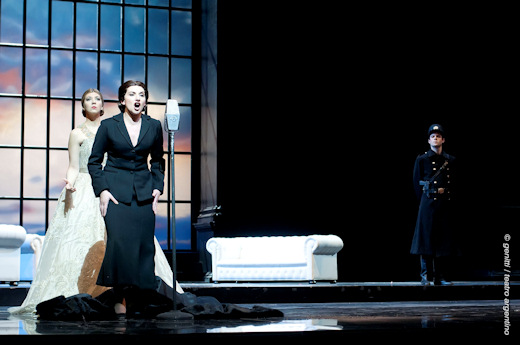Other Links
Editorial Board
-
Editor - Bill Kenny
Assistant Webmaster - Stan Metzger - Founder - Len Mullenger
Google Site Search
SEEN AND HEARD INTERNATIONAL OPERA REVIEW
Handel, Giulio Cesare in Egitto:
Soloists, Chorus and Orchestra of Teatro Argentino. Conductor: Facundo Agudín, Teatro Argentino, La Plata. 1.8.2010 (JSJ)
Director: Gustavo Tambascio
Sets: Daniel Bianco
Costumes: Jesús Ruiz
Lighting: José Luis Fiorruccio
Chorus: Miguel Martínez
Choreography: Yolanda Granado
Cast:
Giulio Cesare: Nidia Palacios
Tolomeo: Flavio Oliver
Cleopatra: Paula Almerares
Cornelia: Cecilia Díaz
Sesto: Adriana Mastrángelo
Aquilas: Sebastián Sorarrain
Nireno: Damián Ramírez
Curio: Mariano Fernández Bustinza

Caption: Nidia Palacios (Giulio Cesare) with Paula Almerares (Cleopatra) behind.
While the baroque era is undergoing a revival in many countries, particularly in Europe, there has been little activity in Argentina so far, although perhaps this is changing with two of Handel’s most popular operas being put on this year. Indeed, the first of these, Giulio Cesare in Egitto, at the Teatro Argentino is the first full baroque production in the theatre’s 120 year history.
A quick scan of offerings on You Tube indicates that almost any setting other than one that is historically accurate goes for this work, and this production from Gustavo Tambascio and team was no exception. The problem, though, was there that there were too many incongruities – men and women alike in hooped skirts, a mixture of baroque and supposedly 1940s dress – e.g. Tolomeo in skirt for “formal” wear, but slick trousers with braces over a bare chest in Act II – a female dressed (Giulia?) Cesare, etc. There was also, for my taste and good though it was, too much dancing.
Conversely there was much to like in this production – again in the case of Tolomeo, who in this production was the most imbued with character, a raw bisexuality that brought to life something of the brutality of the times. The magnificent painted curtain, in place of the normal theatre curtains, was also impressive, but the family statues that kept being wheeled in and out by stagehands, apparently a reference to the Recoleta cemetery in Buenos Aires, were distracting. The placing of a microphone for “Al Lampo ...”, as if it was a pop song, was corny.
On to the music and this was well played by the resident orchestra reduced to chamber proportions under Facundo Agudín, an Argentine now resident in Europe. With an eye on the historical a continuo of harpsichord, cello, theorbo and harp served well for the recitatives.
Among the cast, Uruguayan mezzo Adriana Mastrángelo impressed as an intense and boyishly youthful looking Sesto and Paula Almerares was a warm Cleopatra. Italian countertenor Flavio Oliver was a powerful Tolomeo, a role he specialises in according to the programme notes, but with just occasional lapses of control, and Cecilia Díaz was expressive as Cornelia. Nidia Palacios lacked impact as Giulio Cesare and with a repertoire ranging through the bel canto to Wagner her voice sounds better suited to these roles rather than the florid nature of the baroque. Sebastián Sorarrain as Aquilas, Damián Ramírez as Nireno and Mariano Fernández Bustinza as Curio also all did well.
Jonathan Spencer Jones
Production picture courtesy of Teatro Argentino, La Plata.
